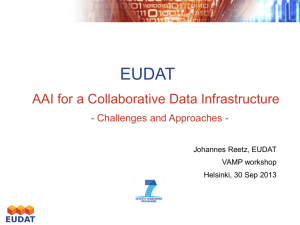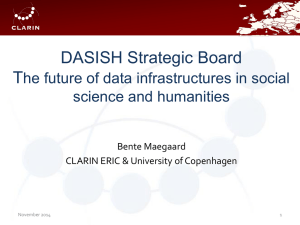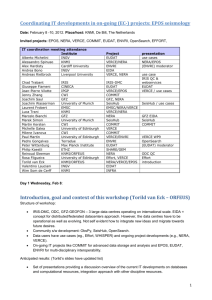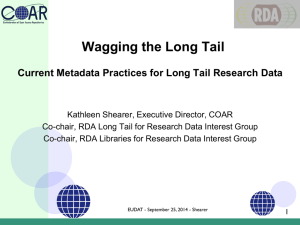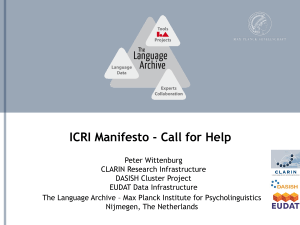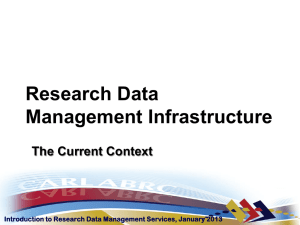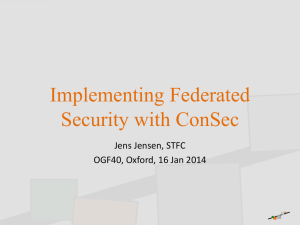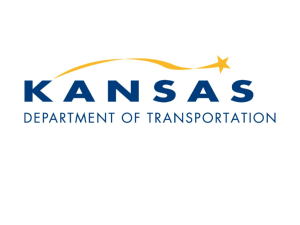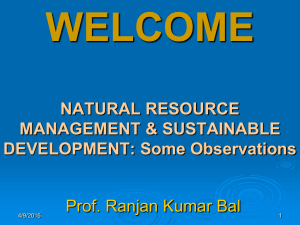EUDAT Presentation Edin
advertisement
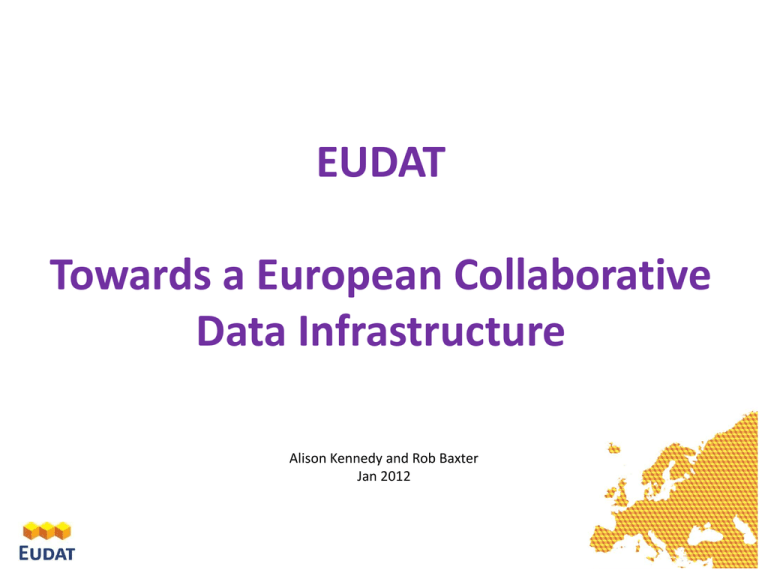
EUDAT Towards a European Collaborative Data Infrastructure Alison Kennedy and Rob Baxter Jan 2012 Outline of the talk EUDAT concept EUDAT consortium EUDAT service approach Expected benefits and challenges of a Collaborative Data Infrastructure EUDAT Key facts and objectives Project Name EUDAT – European Data Start date 1st October 2011 Duration 36 months Budget 16,3 M€ (including 9,3 M€ from the EC) EC call Call 9 (INFRA-2011-1.2.2): Data infrastructure for e-Science (11.2010) Participants 25 partners from 13 countries (national data entities, technology providers, research communities, and funding agencies) Objectives “To deliver cost-efficient and high quality Collaborative Data Infrastructure (CDI) with the capacity and capability for meeting researchers’ needs in a flexible and sustainable way, across geographical and disciplinary boundaries.” The current data infrastructure landscape: challenges and opportunities Long history of data management in Europe: several existing data infrastructures dealing with established and growing user communities (e.g., ESO, ESA, EBI, CERN) New Research Infrastructures are emerging and are also trying to build data infrastructure solutions to meet their needs (CLARIN, EPOS, ELIXIR, ESS, etc.) A large number of projects providing excellent data services (EURO-VO, GENESI-DR, Geo-Seas, HELIO, IMPACT, METAFOR, PESI, SEALS, etc.) However, most of these infrastructures and initiatives address primarily the needs of a specific discipline and user community Challenges Compatibility, interoperability, and cross-disciplinary research how to re-use and recombine data in new scientific contexts (i.e. across disciplinary domains) Data growth in volume and complexity (the so-called “data tsunami”) strong impact on costs threatening the sustainability of the infrastructure Opportunities Potential synergies do exist: although disciplines have different ambitions, they have common basic needs and service requirements that can be matched with generic panEuropean services supporting multiple communities, thus ensuring at the same time greater interoperability. Strategy needed at pan-European level Towards a Collaborative Data Infrastructure Source: HLEG report, p. 31 EUDAT will focus on building a generic data infrastructure layer offering a trusted domain for long term data preservation with services to store, identify, authenticate and mine these data. This need be done in close collaboration with the Communities Collaboration the communities involved in designing specific services and the data centers willing to provide generic solutions (core services must match communities requirements) Community services can also be incorporated into the common data service infrastructure when they are of use to other communities. EUDAT core services Core services are building blocks of EUDAT‘s Common Data Infrastructure mainly included on bottom layer of data services Fundamental Core Services • Long-term preservation • Persistent identifier service • Data access and upload • Workspaces • Web execution and workflow services • Single Sign On (federated AAI) • Monitoring and accounting services • Network services Extended Core Services (community-supported) • Joint meta data service • Joint data mining service No need to match the needs of all at the same time, addressing a group of communities can be very valuable, too The EUDAT Consortium The EUDAT Communities The EUDAT Communities The EUDAT Communities (by field) Biological and Medical Science VPH, ELIXIR, BBRMI, ECRIN Environmental Science ENES, EPOS, Lifewatch, EMSO, IAGOS-ERI, ICOS Social Sciences and Humanities CLARIN Physical Sciences and Engineering WLCG, ISIS Material Science ESS… Energy EUFORIA… EUDAT targets all scientific disciplines (discipline neutral): To enable the capture and identify cross-discipline requirements To involving the scientists of all the communities in the shaping of the infrastructure and its services EUDAT Services Activities – Iterative Design EUDAT’s Services activity is concerned with identification of the types of data services needed by the European research communities, delivering them through a federated data infrastructure and supporting their users 1. Capturing Communities Requirements (WP4) Services to be deployed must be based on user communities needs Strong engagement and collaboration with user communities (EUDAT communities and beyond) to capture requirements 2. Building the services (WP5) User requirements must be matched with available technologies Need to identify: available technologies and tools to develop the required services (technology appraisal) gaps and market failures that should be addressed by EUDAT research activities Services must be designed, built and tested in a pre-production test bed environment and made available to WP4 for evaluation by their users 3. Deploying the services and operating the federated infrastructure (WP6) Services must be deployed on the EUDAT infrastructure and made available to users, with interfaces for cross-site, cross-community operation Infrastructure must provide full life cycle data management services, ensuring the authenticity, integrity, retention and preservation of data, especially those marked for long-term archiving. Capturing Communities Requirements – First steps 1st round of interviews with initial communities (October-December 2011) Series of f2f and phone interviews with ENES, EPOS, CLARIN, VPH and Lifewatch Goals: •Understand how data is organised in each community • Collect first wishes and specific requirements from a common data service layer Outcome • Differences and commonalities found, both on data organisations (e.g. databases, PID systems, etc.) and wishes (e.g. safe/dynamic replication needs). • First shortlist of services identified 2nd round of interviews to refine analysis (December-February 2012) 1st EUDAT User Forum, 7-8 March 2012, Barcelona Getting additional communities involved in the design process and discussion Capturing communities requirements •Continuing existing work with EUDAT core communities •Expanding the analysis to the ”second circle” and other interested communities Building the services SSO Federated AAI Registries Accounting Monitoring PID Integration Replication Up/down load Workspace Services services Meta data Long Term services Preservation Policy/Rule Based services Hosting services Workflow engines Web execution services Moonshot VOMS Cilogon Match technologies and identify Shibboleth SAM-Nagios Deisa Propose solutions Accounting DPMDB BDII EPIC Handle Integration Adapt services to match Replix gaps requirements Cloud Beehup with FTScommunity and SP services Integrate Weblicht Hadoop EasyStore HPSS Test Webdav DMFevaluate Hcatalog and dCache withActiveBPEL communities iCAT iRODSProductize TSM Many more… services * Existing technologies Task 5.1 Scounting Argus for technologies Task 5.2 Candidate Services Tecnology appraisal Building the services Operating the federated infrastructure (WP6) Site B Site A Deputy SUPPORT Services Storage Deputy SUPPORT Services Storage Compute Coordination & Support Network Site A Security Compute Service Provisioning Network Site A Security Resource Provisioning Site C Deputy SUPPORT Services Storage Compute Network Site A Security Site D Deputy SUPPORT Services QA, Security & Storage Compute Network Site A Security 15 Trust Different classes of generic services: community-specific, multi-community, domain-specific and cross-domain services Key strategic pillars for sustainability Sustainability Stakeholders • Research communities • Data projects and initiatives • National Member States • Funders Services • Multidisciplinary services • Meeting real communities needs • Reliable • Innovative Governance • Governance models • Partnerships • Funding models EUDAT Timeline 1st User Forum 2nd User Forum 3rd User Forum 4th User Forum EUDAT Kick-Off Sustainability Plan CrossCommunity Services First Services available Full core Services deployed USER REQUIREMENTS SERVICE DESIGN SERVICE Service DEPLOYMENT deployment 2012 2013 2014 2015 Expected benefits of a Collaborative Data Infrastructure Cost-efficiency through shared resources and economies of scale Better exploitation of synergies between communities and service providers Support to existing scientific communities’ infrastructures and smaller communities Trans-disciplinarity Inter-disciplinary collaboration Communities from different disciplines working together to build services Data sharing between disciplines – re-use and re-purposing Each discipline can solve only part of a problem Cross-border services Data nowadays distributed across states, countries, continents, research groups are international User-driven infrastructure User-centric approach in designing the services, testing and evaluation Strategic user empowerment in governance approach Sustainability Ensuring wide access to and preservation of data Greater access to existing data and better management of data for the future Increased security by managing multiple copies in geographically distant locations Put Europe in a competitive position for important data repositories of world-wide relevance How to join the EUDAT initiative? EUDAT has now 25 partners coming from 13 countries Scaling the infrastructure to other countries and partners is good (increase in complexity and richness, new solutions and practices, etc.) and is needed to build up a pan-European solution EUDAT project team currently defining best way to integrate new partners to the initiative User forums open to all stakeholders interested in adapting their solutions or contributing to the design of the infrastructure Associated membership also being defined to allow external partners to follow and to contribute to the activities of the project.
